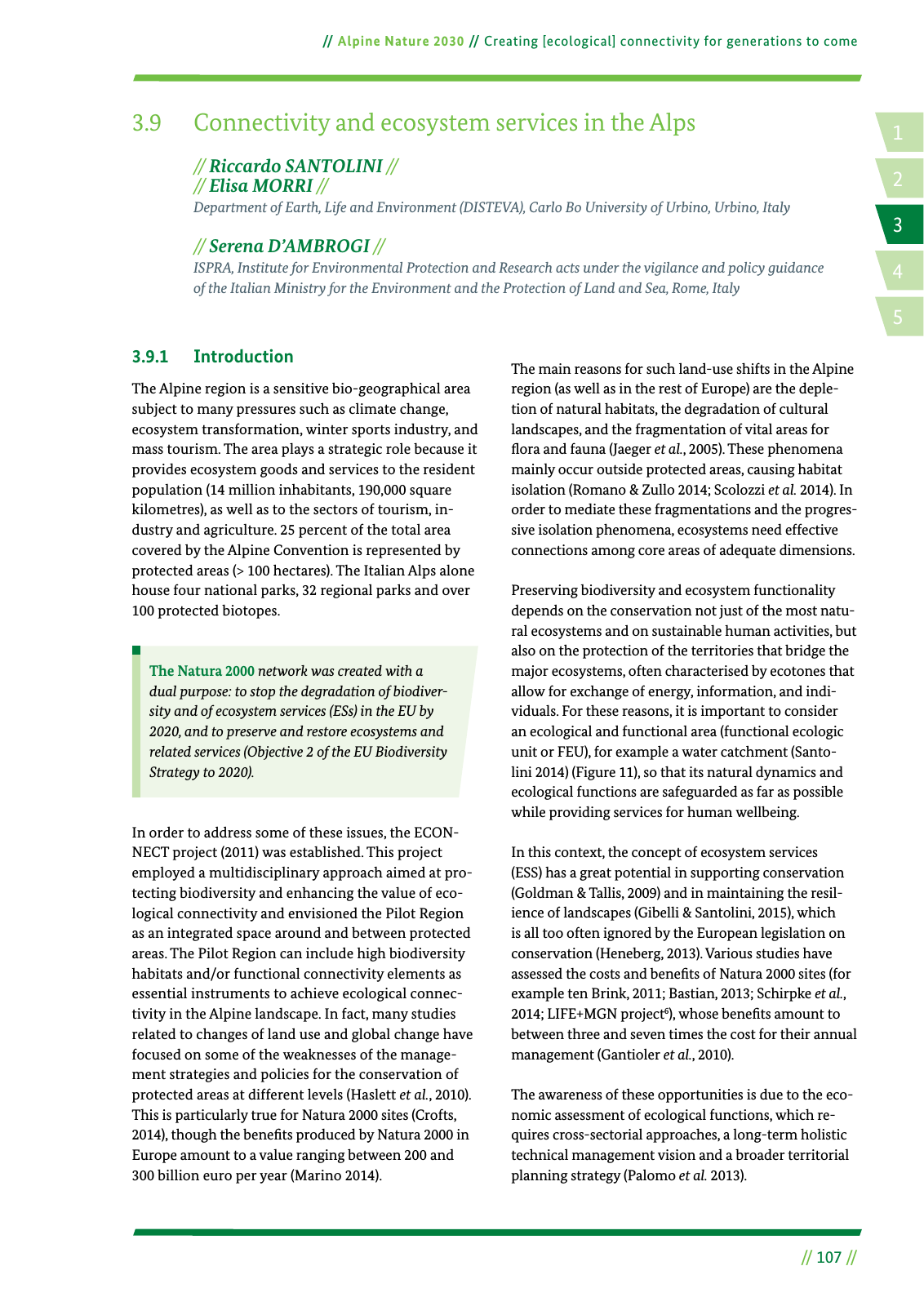14 2 5 3 Alpine Nature 2030 Creating ecological connectivity for generations to come 107 3 9 Connectivity and ecosystem services in the Alps Riccardo SANTOLINI Elisa MORRI Department of Earth Life and Environment DISTEVA Carlo Bo University of Urbino Urbino Italy Serena D AMBROGI ISPRA Institute for Environmental Protection and Research acts under the vigilance and policy guidance of the Italian Ministry for the Environment and the Protection of Land and Sea Rome Italy 3 9 1 Introduction The Alpine region is a sensitive bio geographical area subject to many pressures such as climate change ecosystem transformation winter sports industry and mass tourism The area plays a strategic role because it provides ecosystem goods and services to the resident population 14 million inhabitants 190 000 square kilometres as well as to the sectors of tourism in dustry and agriculture 25 percent of the total area covered by the Alpine Convention is represented by protected areas 100 hectares The Italian Alps alone house four national parks 32 regional parks and over 100 protected biotopes The Natura 2000 network was created with a dual purpose to stop the degradation of biodiver sity and of ecosystem services ESs in the EU by 2020 and to preserve and restore ecosystems and related services Objective 2 of the EU Biodiversity Strategy to 2020 In order to address some of these issues the ECON NECT project 2011 was established This project employed a multidisciplinary approach aimed at pro tecting biodiversity and enhancing the value of eco logical connectivity and envisioned the Pilot Region as an integrated space around and between protected areas The Pilot Region can include high biodiversity habitats and or functional connectivity elements as essential instruments to achieve ecological connec tivity in the Alpine landscape In fact many studies related to changes of land use and global change have focused on some of the weaknesses of the manage ment strategies and policies for the conservation of protected areas at different levels Haslett et al 2010 This is particularly true for Natura 2000 sites Crofts 2014 though the bene ts produced by Natura 2000 in Europe amount to a value ranging between 200 and 300 billion euro per year Marino 2014 The main reasons for such land use shifts in the Alpine region as well as in the rest of Europe are the deple tion of natural habitats the degradation of cultural landscapes and the fragmentation of vital areas for ora and fauna Jaeger et al 2005 These phenomena mainly occur outside protected areas causing habitat isolation Romano Zullo 2014 Scolozzi et al 2014 In order to mediate these fragmentations and the progres sive isolation phenomena ecosystems need effective connections among core areas of adequate dimensions Preserving biodiversity and ecosystem functionality depends on the conservation not just of the most natu ral ecosystems and on sustainable human activities but also on the protection of the territories that bridge the major ecosystems often characterised by ecotones that allow for exchange of energy information and indi viduals For these reasons it is important to consider an ecological and functional area functional ecologic unit or FEU for example a water catchment Santo lini 2014 Figure 11 so that its natural dynamics and ecological functions are safeguarded as far as possible while providing services for human wellbeing In this context the concept of ecosystem services ESS has a great potential in supporting conservation Goldman Tallis 2009 and in maintaining the resil ience of landscapes Gibelli Santolini 2015 which is all too often ignored by the European legislation on conservation Heneberg 2013 Various studies have assessed the costs and bene ts of Natura 2000 sites for example ten Brink 2011 Bastian 2013 Schirpke et al 2014 LIFE MGN project6 whose bene ts amount to between three and seven times the cost for their annual management Gantioler et al 2010 The awareness of these opportunities is due to the eco nomic assessment of ecological functions which re quires cross sectorial approaches a long term holistic technical management vision and a broader territorial planning strategy Palomo et al 2013

Hinweis: Dies ist eine maschinenlesbare No-Flash Ansicht.
Klicken Sie hier um zur Online-Version zu gelangen.
Klicken Sie hier um zur Online-Version zu gelangen.